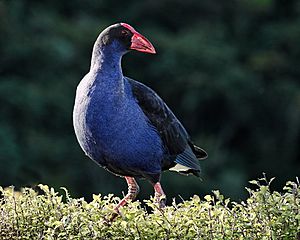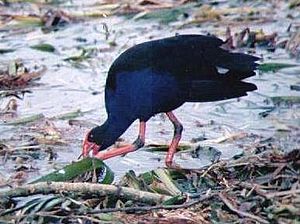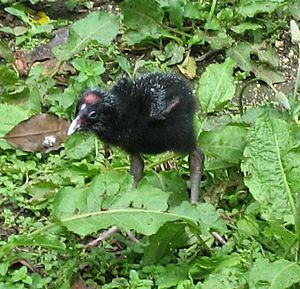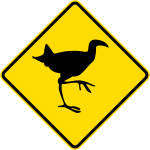Australasian swamphen facts for kids
Quick facts for kids Australasian swamphen |
|
|---|---|
 |
|
| P. melanotus at Waikawa, Marlborough, New Zealand | |
| Scientific classification | |
| Genus: |
Porphyrio
|
| Species: |
melanotus
|
| Synonyms | |
|
Porphyrio porphyrio melanotus |
|
The Australasian swamphen (Porphyrio melanotus) is a type of bird known for living in swampy areas. It's found in places like eastern Indonesia, Papua New Guinea, Australia, and New Zealand. In New Zealand, this bird has a special name: the pukeko, which comes from the Māori word pūkeko. This bird used to be thought of as a smaller group within the larger purple swamphen family.
Contents
Where Do Australasian Swamphens Live?
These swamphens live across a wide area. You can find them in mainland Australia, eastern Indonesia (including the Moluccas, Aru, and Kai Islands), and Papua New Guinea. They also live on New Zealand's main islands, as well as the Chatham and Kermadec Islands.
Australasian swamphens have a small shield-like plate on their forehead. Their upper body is black, and their throat and chest are a purple color.
How Pukeko Arrived in New Zealand
Scientists believe the pukeko arrived in New Zealand about 1,000 years ago. They might have flown there from Australia on their own. This is because swamphens are known to fly long distances over the sea. For example, a dead pukeko was once found on a tiny, isolated rock called L'Esperance Rock, which is over 200 kilometers away from any known pukeko population! This shows how far they can travel.
Some Māori stories also suggest that ancestors brought pukeko to New Zealand on their canoes, like the Horouta and Aotea.
What Do Australasian Swamphens Look Like?
Pukeko in New Zealand are a bit larger than those in mainland Australia, but they look very similar. When they feel threatened, they usually prefer to walk away from danger instead of flying. If they do fly, their take-offs and landings can look a bit clumsy. They usually only fly short distances.
Swamphen Life and Habits
Australasian swamphens are thought to be the ancestors of several other island bird species. This includes the extinct Lord Howe swamphen and two types of takahē in New Zealand.
These birds often live in groups, usually with 3 to 12 individuals. They are known to work together. If a predator like an Australasian harrier attacks their nest, they will shriek loudly as a group to defend it. If they can't scare off the predator, they might leave their nest. Even with new predators like cats, rodents, and mustelids (like stoats and ferrets) in New Zealand, pukeko have managed to do well.
Australasian Swamphens in Culture
The color red was very important to Māori people in New Zealand. It was linked to nobility and power. Because the pukeko has a red beak and red legs, it was highly respected. Sometimes, chiefs even kept them as pets.
In Samoa, the swamphen is called manuali'i, which means "chiefly bird." Red was a prized color for important people in Polynesia. While other birds with red feathers were valued, the swamphen was special because its prestige came from its red face, beak, and legs. In old Samoa, only chiefs were allowed to keep these birds as pets. Early European sailors saw Samoan chiefs treating swamphens as tamed pets. Some Samoans also believed the swamphen was a mischievous spirit. People usually didn't hunt swamphens for food, unless it was absolutely necessary.
Māori Sayings About Pukeko
Pukeko are known for being bold and determined. In the past, they would sometimes raid gardens to steal kumara (sweet potato) and taro. If someone was stubborn or annoying, they might be compared to the bird. People would say they had "pukeko ears" (taringa Pākura). Pukeko are also known to steal eggs from each other, which shows their tricky nature.
Pukeko in Māori Myths
The pukeko appears in the Māori myth "How the Kiwi lost her wings." In this story, several forest birds are asked to come down from the trees to eat bugs and save the forest. All the birds make excuses except the kiwi, who agrees to give up its colors and ability to fly. The pukeko's excuse is that the ground looks too wet, and it doesn't want to get its feet wet. For this, the pukeko is punished and told it must live forever in the swamps.
Another story says the pukeko is related to Punga, who is the ancestor of sharks and reptiles. But a high chief named Tawhaki claimed the pukeko as his own. Tawhaki cut himself while working with wood and put his blood on the pukeko's forehead. This showed their special connection. So, the mischievous pukeko gets its tricky personality from Punga and its noble mark from Tawhaki.
Hunting and Protecting Pukeko
In New Zealand, pukeko are protected as native gamebirds. This means people can only hunt them with a special license from Fish and Game during the duck hunting season. They are not usually hunted for food because their meat is considered tough.
More than 100 years ago, Māori people would trap pukeko near Lake Taupō. They would set up stakes connected by a thin flax string. From this string, they would hang hair-like loops made from cabbage tree fibers. These loops would catch pukeko as they fed in the low light after sunset.
In New Zealand and Australia, the number of pukeko has grown. This is because new artificial lakes and ponds have been created, which are good habitats for them.
Pukeko Life Cycle
Pukeko usually nest in hidden spots, often in the middle of clumps of raupo plants. In New Zealand, they nest between August (late winter) and March (early autumn). Most eggs are laid from August to February, with the most breeding happening in spring, from September to December.
New Zealand pukeko are known for "joint-nesting." This means multiple female birds will lay their eggs in the same nest.
Pukeko and Roads
You can often see pukeko alone or in small groups of two or three. They look for food and small stones (grit) beside roads and ditches. A study showed that they prefer red grit, even though it's less common on roads. Sadly, being hit by cars is a cause of death for these birds.
See also
 In Spanish: Calamón pukeko para niños
In Spanish: Calamón pukeko para niños




